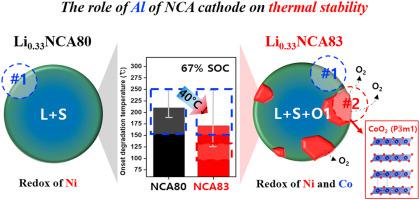Nano Energy ( IF 16.8 ) Pub Date : 2020-09-10 , DOI: 10.1016/j.nanoen.2020.105367 Eunmi Jo , Jae-Ho Park , Junbeom Park , Jieun Hwang , Kyung Yoon Chung , Kyung-Wan Nam , Seung Min Kim , Wonyoung Chang

|
Despite increasing demands for higher energy density cathode materials, they can be bigger threats unless thermal stability is guaranteed. Herein, the thermal stability of LixNi0.835Co0.15Al0.015O2 (NCA83) and LixNi0.8Co0.15Al0.05O2 (NCA80) is compared by using in-situ transmission electron microscopy. Analysis demonstrates that NCA83 and NCA80 degrade thermally by distinct mechanisms. Al prevents the transition to CoO2-type O1 phase by suppressing O-slab gliding by residual Li. At 67% SOC, in the sub-surface area, thermal degradation of NCA80 is mainly due to reduction of Ni, whereas thermal degradation of NCA83 is a result of concurrent reduction of Ni and Co. The difference indicates that NCA83 has both earlier transition to the rock-salt structure and poorer thermal stability than NCA80. This study presents a protocol to properly evaluate new high energy density cathode materials, and provides important insights into the thermal degradation mechanism of Ni-based layered oxides.
中文翻译:

不同的热降解机理:铝在富镍层状阴极材料中的作用
尽管对更高能量密度的阴极材料的需求不断增加,但除非保证热稳定性,否则它们可能是更大的威胁。在此,使用原位透射电子显微镜比较了Li x Ni 0.835 Co 0.15 Al 0.015 O 2(NCA83)和Li x Ni 0.8 Co 0.15 Al 0.05 O 2(NCA80)的热稳定性。分析表明,NCA83和NCA80通过不同的机理热降解。Al阻止过渡到CoO 2通过抑制残留锂引起的O型平板滑动,使O1型O1相产生。在SOC为67%时,在次表面区域,NCA80的热降解主要是由于Ni的还原,而NCA83的热降解是同时还原Ni和Co的结果。岩石盐结构和热稳定性较NCA80差。这项研究提出了一个协议,以适当地评估新型高能量密度阴极材料,并提供了对镍基层状氧化物的热降解机理的重要见解。











































 京公网安备 11010802027423号
京公网安备 11010802027423号